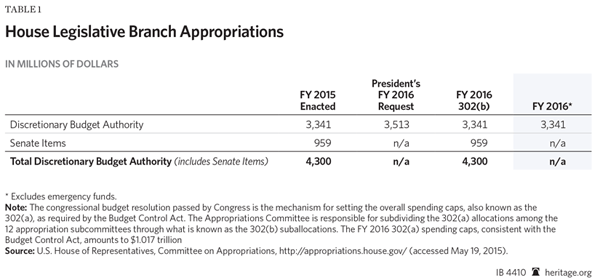Next week, the House of Representatives is expected to consider the legislative branch appropriations bill, the third of 12 appropriations bills providing discretionary funding for the federal government. The legislative branch appropriations bill provides general funding for the overall operation of Congress, including the U.S. Capitol Police (USCP); the Government Publishing Office (GPO); the Government Accountability Office (GAO); the Congressional Budget Office (CBO); and others.
The bill provides $3.34 billion in budget authority, matching the current year’s funding level. It includes a $1 billion hole, intentionally designed as a placeholder for Senate funding. Long-standing tradition allows each chamber to consider its own funding requirements.
Although the bill freezes spending, it fails to take advantage of several opportunities to cut spending. For example, the bill increases funding for the Capitol Police by $21 million and for the CBO by $1.5 million. These increases are offset by reductions in funding for the Architect of the Capitol, the GPO, and the Open World Leadership Center. This bill should realize those cuts instead of using them to increase spending elsewhere.
U.S. Capitol Police
The bill provides the USCP $369 million, more than $21 million above fiscal year (FY) 2015 levels. The USCP is a federal law enforcement agency charged with protecting Congress, the Capitol complex, employees, and visitors. With 1,775 sworn officers and another 370 civilian personnel,[1] there is one USCP officer for every five staffers or Members of Congress.[2] The force is nearly one-third the size of the entire U.S. Secret Service force.
Recommendation. The bill should freeze funding for the U.S. Capitol Police at current levels, which would save more than $20 million. The Capitol Police force is one of the highest paid federal law enforcement agencies. The USCP minimum starting salary is $55,653, while the FBI starting salary is $43,114.[3] The high USCP officer base pay does not account for the $31 million in estimated overtime pay next year—nearly 10 percent of the USCP operating budget.
John Stennis Center
The John Stennis Center is a legislative program intended to be a living tribute to John Stennis’s (D–MS) career as a Senator. The bill would provide $430,000 for the program, the same funding level as was provided in FY 2015. According to its materials, the Center’s agenda is to attract youth to careers in public service, promote leadership skills, and encourage friendships among like-minded public servants.
Recommendation. While budget deficits remain high at a level projected to top $1 trillion in the coming decade, Congress is the first place to start when discussing spending priorities. There are countless private entities providing services similar to the Stennis Center program. The Young Leaders program at The Heritage Foundation is one example. The John Stennis Center program was eliminated in the FY 2013 House legislative branch appropriation bill and should be eliminated in this bill as well.
Conclusion
The legislative branch appropriations bill deserves praise for leaving funding levels constant at FY 2015 levels, but it fails to capitalize on several opportunities to save taxpayers money. Programs like the John Stennis Center should be further reduced or eliminated entirely. The Capitol Police force should reduce large overtime expenses and make their salaries consistent with other federal law enforcement agencies. These small changes could save taxpayers millions of dollars.
—John Gray is a Research Fellow in Federal Fiscal Affairs in the Thomas A. Roe Institute for Economic Policy Studies, of the Institute for Economic Freedom and Opportunity, at The Heritage Foundation.

